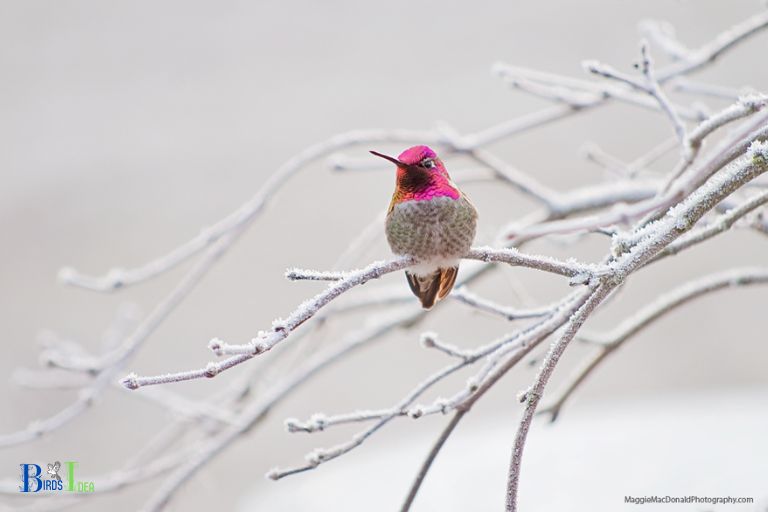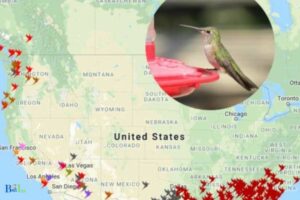When Do Hummingbirds Leave New Mexico: Aug-Oct!
Hummingbirds typically leave New Mexico in the autumn to migrate south for the winter. Typically, they start to head south in early to mid-August and are often gone by early October.
As temperatures start to drop, indicating the arrival of fall, they embark on a journey south to escape the cold.
This migration usually starts around mid-September to early October, but can vary slightly depending on local weather conditions and food supply.
Four things to know about hummingbird migration in New Mexico:
Hummingbirds are remarkable creatures that carry out a fascinating annual migration.
Each year, in response to changing weather patterns and food sources, they leave New Mexico in the autumn and migrate south for the winter.
While the exact timing of departure can vary depending on the species and weather, most leave by the first week of October.
5 Species of Hummingbirds Leave New Mexico
| Species | Arrival Time | Departure Time |
| Black-chinned Hummingbird | Mid-April | Late-August/Early-September |
| Broad-tailed Hummingbird | Late-April | Mid-September |
| Rufous Hummingbird | Early-July | Late-September |
| Calliope Hummingbird | Late-July | Mid-September |
| Anna’s Hummingbird | Irregular | Irregular |
Key Takeaway

Five Facts About: Hummingbirds Leave New Mexico
DID YOU KNOW
Each year, millions of hummingbirds migrate from the United States and Canada to Mexico and Central America.
Introduction to Hummingbird Migration
Hummingbirds are small, colorful birds that migrate each year from their summer breeding grounds to their winter habitats.
They are one of the most fascinating creatures in the bird world, and their migratory journeys can be quite incredible.

Hummingbirds migrate for a variety of reasons, including food availability, breeding grounds, and climate changes.
They typically migrate from northern regions to warmer climates, but some species may also travel from the tropics to higher elevations.
Here are some interesting facts about hummingbird migration:
- Many species of hummingbirds migrate twice a year, while others may migrate only once.
- Some hummingbirds travel as far as 2000 miles during a single migration.
- Hummingbirds may fly alone or in large groups of hundreds of birds.
- Hummingbirds use their wings to fly and feed on nectar, which gives them the energy to complete their migrations.
- Migration can take up to several weeks, with some species taking as long as two months to reach their destination.
- Hummingbirds use the stars and geographic landmarks to navigate and find their way during their journey.
Hummingbird migration is a fascinating phenomenon that continues to captivate and inspire bird watchers around the world.
By understanding more about this incredible process, we can help to protect and conserve these amazing creatures.
What Causes Hummingbirds to Migrate?
Migration is an instinctive behavior in many species of hummingbirds, and the main reason for this is seasonal change.
As the weather gets warmer, more food becomes available, prompting the birds to travel to new places. Hummingbirds migrate in order to find food, shelter and breeding grounds.

As winter approaches, the birds are driven by a natural instinct to find warmer climates and more abundant food sources. They fly south to warmer climates in the fall, and back north to cooler climates in the spring.
To complete their migration, the hummingbirds rely on their instincts and several other factors, such as the air temperature, the amount of light, and the availability of food.
Some species of hummingbirds migrate as far as Central and South America, while others migrate only short distances.
The following are the factors that cause hummingbirds to migrate:
Seasonal change: Hummingbirds migrate in response to the changing of the seasons, specifically winter and spring.
Food: Hummingbirds migrate in order to find food sources, as winter cuts off their food sources in their native habitats.
Breeding: Hummingbirds migrate in search of suitable breeding grounds, as their native habitats may not have the right climate or resources.
Temperature: Hummingbirds migrate in response to the changing temperatures of their native habitats, as they need to find warmer climates.
Light: Hummingbirds migrate in response to the amount of light, which governs their food sources and living conditions.
“Migration is the grandest of all journeys, an elemental urge rooted deep in the soul and timed to the turning of the earth.”
birdsidea
Where Do Different Types of Hummingbirds Migrate to?
Different species of hummingbirds migrate to different locations depending on the season.
Generally, hummingbirds migrate in the winter as they follow the blooming of flowers, insects, and other food sources.

Below is a list of some common types of hummingbirds and their general migratory patterns:
Anna’s Hummingbird: Migrates from western Canada and the northwestern United States to California and Arizona
Black-chinned Hummingbird: Migrates from the northern United States and southern Canada to the southwestern United States and northern Mexico
Calliope Hummingbird: Migrates from the northwestern United States and western Canada to Mexico
Costa’s Hummingbird: Migrates from southern California and Arizona to Mexico
Rufous Hummingbird: Migrates from southern Alaska and northwestern Canada to western Mexico
Ruby-throated Hummingbird: Migrates from southern Canada to the Gulf Coast and southeastern United States
Broad-tailed Hummingbird: Migrates from the mountainous western United States to Mexico.
In general, hummingbirds migrate south in the winter and north in the summer. They will often travel thousands of miles to reach their destination.
Why Do So Many Hummingbirds Gather in New Mexico?
New Mexico is home to an abundance of hummingbirds, attracting birdwatchers from all over the world.
The reasons why hummingbirds flock to this region are numerous, with the combination of climate and natural resources providing a perfect habitat for these birds to thrive.

Here are some of the key factors why hummingbirds gather in New Mexico:
Mild temperatures and sunny weather:
The region’s mild temperatures, abundant sunshine, and relatively low humidity make it an ideal environment for hummingbirds to survive and thrive.
Abundant food sources:
Hummingbirds require large amounts of energy to maintain their high metabolisms, so having an abundance of nectar-producing flowers and insect and arthropod populations are a bonus for them.
Plenty of shelter:
The region is blessed with an abundance of trees, shrubs, and other plant species, providing plenty of shelter and protection from predators.
Safe migration routes:
New Mexico is conveniently located along a major migratory route, allowing hummingbirds to flock to the region in order to rest, feed, and reproduce.
These factors make New Mexico an excellent destination for hummingbirds, and it’s no wonder they gather here in such large numbers.
When Do Hummingbirds Typically Leave New Mexico?
Most hummingbirds in New Mexico migrate south in autumn and winter. Typically, hummingbirds in New Mexico begin to migrate in late August and early September.
The migration typically continues until late October to early November. The timing of the migration varies depending on the species of hummingbird, weather conditions, and food availability.

Generally, the Rufous Hummingbird is the first to start migrating, with the Black-chinned, Broad-tailed and Calliope Hummingbirds following soon after.
In the spring, hummingbirds make their return to New Mexico, usually beginning in late March and continuing through mid-May.
The same factors, such as species of hummingbird and weather conditions, that affect the timing of the fall migration also apply to the return migration.
How Does Weather Impact Hummingbird Migration?
Weather is a significant factor in the migration patterns of hummingbirds. It directly impacts the food sources and habitats hummingbirds rely on for their survival.

Here are some of the ways weather affects hummingbird migration:
Temperature: Hummingbirds rely on warmer temperatures for their energy needs. Warmer weather usually provides greater access to food sources and encourages migration.
Rainfall: Hummingbirds need nectar from flowers and insects for their nutrition. Heavy rains can limit nectar and insect availability, prompting hummingbirds to move to different areas.
Wind: Winds can also impact a hummingbird’s migration. Strong winds can push the birds off their normal course and make it hard for them to reach their desired destination.
Storms: Severe storms can be dangerous for hummingbirds. They can interfere with the bird’s ability to feed, causing them to leave an area sooner than normal.
In conclusion, weather plays a major role in the migration of hummingbirds. They rely on specific weather conditions to access food sources, habitats, and reach their desired destinations.
What Can We Learn from Hummingbirds’ Migration?
Hummingbirds are tiny, yet mighty birds that have a remarkable ability to migrate, often traveling thousands of miles each year.
Many species of hummingbirds migrate, and they have been known to fly in all directions – up, down, east, and west.

Here are a few lessons we can learn from their annual migration:
Migration Requires Planning and Preparation:
Hummingbirds migrate in order to survive and find food. They spend months or even years planning their route in order to find the best food sources.
In the same way, we should take the time to plan our projects or goals and take the necessary steps to prepare for success.
Determination and Perseverance are Essential:
Despite the long distances and difficult conditions, hummingbirds don’t give up. They have remarkable endurance and a determination that allows them to keep going, no matter the odds.
Similarly, we should maintain a determined attitude and keep going even in the face of obstacles.
Local Resources can be Harnessed:
Hummingbirds are able to tap into local resources to ensure their migration is successful. They take advantage of favorable winds, food sources, and roosting spots.
In our own lives, we should take advantage of the resources available to us, whether it’s a supportive friend, a helpful mentor, or other valuable contacts.
Hummingbirds are truly remarkable animals, and we can learn a lot from their annual migration.
By taking the lessons learned from their journey, we can apply their wisdom to our own lives and use it to help us plan, per
FAQ of When Do Hummingbirds Leave New Mexico
When do hummingbirds typically leave New Mexico?
How long will they stay in New Mexico?
What environmental factors cause hummingbirds to migrate?
Where do hummingbirds migrate to from New Mexico?
Are there any particular species of hummingbirds that are more likely to stay in New Mexico?
Conclusion
Hummingbirds leave New Mexico in the autumn for their winter migration. Different species may depart at different times, but most hummingbirds leave by early October.
The abundance of food sources in New Mexico and its warm climate attract a wide variety of these avian visitors who, in turn, present a beautiful and unique annual spectacle.






